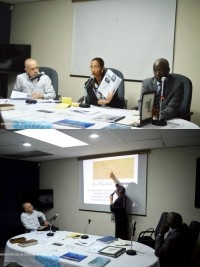
Michael Murray
Michael has specialised in maritime archaeology since 1997. Prior to Wessex, he worked for a variety of archaeological organisations, including the Institute of Nautical Archaeology (INA) on his first underwater archaeological excavation of the Monti Christi Pipewreck in the summer of 1997. Following this, he was a volunteer archaeological diver on the Aucilla River Prehistory Project in 1998. His terrestrial experience comes from serving as an archaeology student on the Tolo Lake Excavation project in Northern Idaho with the University of Idaho and more recently on a phase III Woodland Era site in Northern Arkansas for Panamerican Consultants, Inc. Michael has also worked for a number of years within the historic tallship industry as an Able-Bodied Seaman and Captain. This culminated in the creation of his own underwater archaeological outreach program aboard an 1833 replica pilot schooner in St. Augustine, Florida and ran part-time from 2007 to 2010.
Michael’s most extensive experience comes from working as a maritime archaeologist for Panamerican Consultants, Inc.; the longest running and most active SCRM in North America that offers submerged cultural resource management services throughout the United States and the Caribbean. Michael has logged almost 100 surface-supplied archaeological dives with SEARCH and Panamerican and well over 200 combined commercial, scientific and recreational dives in his career. Recently, he supervised two archaeological diving projects for Panamerican and one foreshore survey. The latter involved leading a team for four weeks that documented 117 historic rice plantation sites in an intertidal zone using a 17- foot Carolina skiff on the Savannah River. He has also been responsible for generating a dozen archaeological reports for Panamerican that include an extensive amount of historic archival work as well as magnetometer, sub-bottom profile, and side-scan sonar data processing and analysis.
Michael’s role as a maritime archaeologist for various organisations has also meant that he has developed the necessary skills and experience that are essential for working effectively with a wide range of clients, curators and stakeholders. He has directed or otherwise been responsible for significant work on a wide variety of important sites including the Mont-Christi Pipewreck (a 17th Century Dutch shipwreck with the 3rd largest cache of Dutch clay pipes found in the Western Hemisphere), the excavations of the Civil War tin and wooden clad ships Echo and Undine, the Marble Wreck, the Western World, and the Mexico. Most recently, he has been involved in the highly publicised initial stages of recording and raising the CSS Georgia; the first iron-clad vessel that the Confederates built in 1862 and sank in 1864. Currently, Michael is working on a PhD at the University of Southampton that involves the use of a highly innovative underwater laser scanning device developed by 2G Robotics based in Waterloo, Ontario. A strong component of this project is to ascertain its efficacy for historic shipwreck management and monitoring.





